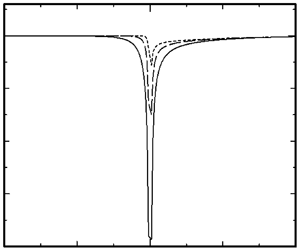Published online by Cambridge University Press: 27 May 2024

The initial flow past an impulsively started rotating and translating circular cylinder is asymptotically analysed using a Brinkman penalization method on the Navier–Stokes equation. In our previous study (J. Fluid Mech., vol. 929, 2021, A31), the asymptotic solution was obtained within the second approximation with respect to the small parameter,  $\epsilon$, that is of the order of
$\epsilon$, that is of the order of  $1 / \lambda$. Here,
$1 / \lambda$. Here,  $\lambda$ is the penalization parameter. In addition, the Reynolds number based on the cylinder radius and the translating velocity is assumed to be of the order of
$\lambda$ is the penalization parameter. In addition, the Reynolds number based on the cylinder radius and the translating velocity is assumed to be of the order of  $\epsilon$. The previous study asymptotically analysed the initial flow past an impulsively started translating circular cylinder and investigated the influence of the penalization parameter
$\epsilon$. The previous study asymptotically analysed the initial flow past an impulsively started translating circular cylinder and investigated the influence of the penalization parameter  $\lambda$ on the drag coefficient. It was concluded that the drag coefficient calculated from the integration of the penalization term exhibits a half-value of the results of Bar-Lev & Yang (J. Fluid Mech., vol. 72, 1975, pp. 625–647) as
$\lambda$ on the drag coefficient. It was concluded that the drag coefficient calculated from the integration of the penalization term exhibits a half-value of the results of Bar-Lev & Yang (J. Fluid Mech., vol. 72, 1975, pp. 625–647) as  $\lambda \to \infty$. Furthermore, the derivative of vorticity in the normal direction was found to be discontinuous on the cylinder surface, which is caused by the tangential gradient of the pressure on the cylinder surface. The present study hence aims to investigate the variance on the drag coefficient against the result of Bar-Lev & Yang (1975). First, we investigate the problem of an impulsively started rotating circular cylinder. In this situation, the moment coefficient is independent of the pressure on the cylinder surface so that we can elucidate the role of the pressure to the hydrodynamic coefficients. Then, the problem of an impulsively started rotating and translating circular cylinder is investigated. In this situation, the pressure force induced by the unsteady flow far from the cylinder is found to play a key role on the drag force for the agreement with the result of Bar-Lev & Yang (1975), whereas the variance still exists on the lift force. To resolve the variance, an alternative formula to calculate the hydrodynamic force is derived, assuming that there is the pressure jump between the outside and inside of the cylinder surface. The pressure jump is obtained in this analysis asymptotically. Of particular interest is the fact that this pressure jump can cause the variance on the lift force calculated by the integration of the penalization term.
$\lambda \to \infty$. Furthermore, the derivative of vorticity in the normal direction was found to be discontinuous on the cylinder surface, which is caused by the tangential gradient of the pressure on the cylinder surface. The present study hence aims to investigate the variance on the drag coefficient against the result of Bar-Lev & Yang (1975). First, we investigate the problem of an impulsively started rotating circular cylinder. In this situation, the moment coefficient is independent of the pressure on the cylinder surface so that we can elucidate the role of the pressure to the hydrodynamic coefficients. Then, the problem of an impulsively started rotating and translating circular cylinder is investigated. In this situation, the pressure force induced by the unsteady flow far from the cylinder is found to play a key role on the drag force for the agreement with the result of Bar-Lev & Yang (1975), whereas the variance still exists on the lift force. To resolve the variance, an alternative formula to calculate the hydrodynamic force is derived, assuming that there is the pressure jump between the outside and inside of the cylinder surface. The pressure jump is obtained in this analysis asymptotically. Of particular interest is the fact that this pressure jump can cause the variance on the lift force calculated by the integration of the penalization term.